Last updated on September 19th, 2023 at 10:29 pm
The pattern of INBDE Exam is very specific and unique.
If you are planning to enroll in a DDS Course in America you will first need to clear the INBDE exam.
Understanding the pattern of INBDE exam is of utmost importance if you wish to clear the exam in your first attempt .
The Domain of Dentistry serves as the content domain for the INBDE.
Table of Contents
Introduction
The Integrated National Board Dental Examination (INBDE) is a comprehensive examination designed for dental candidates in the United States.
It serves as a unified replacement for the National Board Dental Examination (NBDE) Part I and Part II.
Here’s an overview of the exam pattern for the INBDE:
- Format: The INBDE is a computer-based examination.
- Total Exam Duration: The INBDE is a two-day examination, with each day having a specific focus.
- Day 1: Emphasizes basic biomedical and dental sciences.
- Day 2: Focuses on clinical dental sciences and patient management.
- Number of Sections: Each day of the INBDE consists of multiple sections, with a variety of question formats.
- Day 1: Includes multiple-choice questions (MCQs), case-based items, and standalone items.
- Day 2: Primarily features case-based items and standalone items.
- Scoring: The INBDE is a pass/fail examination. Candidates need to achieve a passing score to successfully complete the examination. There is no numerical scoring, and the passing threshold is determined by the Joint Commission on National Dental Examinations (JCNDE).
- Timing: Each section of the INBDE has a specified time limit, and candidates must manage their time effectively to complete all the question.See time duration.
Subjects and Topics
INDBE has divided all topics into 10 Foundation Knowledge Areas and 56 Clinical content areas.
- Content Areas: The INBDE assesses a wide range of topics related to dentistry, including biomedical and dental sciences, clinical sciences, patient management, and ethical and legal issues.
- Day 1 Content Areas: Day 1 covers areas such as:
- Anatomy and Histology
- Biochemistry
- Physiology
- Microbiology
- Pathology
- Pharmacology
- Dental Anatomy
- Occlusion
- Dental Materials
- Ethics and Jurisprudence
- Day 2 Content Areas: Day 2 focuses on clinical dentistry and includes topics like:
- Diagnosis and Treatment Planning
- Preventive Dentistry
- Oral and Maxillofacial Surgery
- Periodontics
- Orthodontics
- Pediatric Dentistry
- Prosthodontics
- Operative Dentistry
- Endodontics
- Oral Medicine
- Radiology
- Oral Pathology
- Dental Public Health
- Ethics and Jurisprudence
Clinical Content Areas
These areas are grouped into three component sections: Diagnosis and Treatment Planning, Oral
Health Management, and Practice and Profession.
1. Diagnosis and Treatment Planning
Diagnosis and Treatment Planning includes all aspects of diagnosis, assessment, interpretation of laboratory
results, physical evaluation of structure, appearance and function, as well as background, characteristics,
circumstances, underlying conditions and psychological, social or behavioral influences to derive an accurate
diagnosis and treatment plan, as well as reasonable and safe treatment alternatives for any patient.
In simple words- Diagnosis and Treatment Planning covers everything in patient care, from providing and adjusting treatment to evaluating outcomes and addressing any issues that come up during oral healthcare.
| Number | Competency Description |
|---|---|
| 1 | Interpret patient information and medical data to assess and manage patients. |
| 2 | Identify the chief complaint and understand the contributing factors. |
| 3 | Perform head and neck and intraoral examinations, interpreting and evaluating the clinical findings. |
| 4 | Use clinical and epidemiological data to diagnose and establish a prognosis for dental abnormalities and pathology. |
| 5 | Recognize the normal range of clinical findings and distinguish significant deviations that require monitoring, treatment, or management. |
| 6 | Predict the most likely diagnostic result given available patient information. |
| 7 | Interpret diagnostic results to inform understanding of the patient’s condition. |
| 8 | Recognize the manifestations of systemic disease and how the disease and its management may affect the delivery of dental care. |
| 9 | Recognize the interrelationship between oral health and systemic disease, and implement strategies for improving overall health. |
| 10 | Select the diagnostic tools most likely to establish or confirm the diagnosis. |
| 11 | Collect information from diverse sources (patient, guardian, patient records, allied staff, and other healthcare professionals) to make informed decisions. |
| 12 | Formulate a comprehensive diagnosis and treatment plan for patient management. |
| 13 | Discuss etiologies, treatment alternatives, and prognoses with patients so they are educated and can make informed decisions concerning the management of their care. |
| 14 | Understand how patient attributes (e.g., gender, age, race, ethnicity, and special needs), social background and values influence the provision of oral health care at all stages of life. |
| 15 | Interact and communicate with patients using psychological, social, and behavioral |
2.Oral Health Management
Oral Health Management includes all aspects of patient care delivery, including provision and modification
of treatment, handling of complications, intervention outcomes assessment, and all developments that arise
in the course of managing a patient’s oral health care.
In simple words – Oral Health Management covers everything related to patient care, from treatment to assessing outcomes and dealing with any issues that may arise during oral healthcare
| Number | Competency Description |
|---|---|
| 16 | Prevent, recognize and manage medical emergencies (e.g., cardiac arrest). |
| 17 | Prevent, recognize and manage dental emergencies. |
| 18 | Recognize and manage acute pain, hemorrhage, trauma, and infection of the orofacial complex. |
| 19 | Prevent, diagnose and manage pain during treatment. |
| 20 | Prevent, diagnose and manage pulpal and periradicular diseases. |
| 21 | Prevent, diagnose and manage caries. |
| 22 | Prevent, diagnose and manage periodontal diseases. |
| 23 | Prevent, diagnose and manage oral mucosal and osseous diseases. |
| 24 | Recognize, manage and report patient abuse and neglect. |
| 25 | Recognize and manage substance abuse. |
| 26 | Select and administer or prescribe pharmacological agents in the treatment of dental patients. |
| 27 | Anticipate, prevent, and manage complications arising from the use of therapeutic and pharmacological agents in patient care. |
| 28 | Diagnose endodontic conditions and perform endodontic procedures. |
| 29 | Diagnose and manage the restorative needs of edentulous and partially edentulous patients. |
| 30 | Restore tooth function, structure, and esthetics by replacing missing and defective tooth structure, while promoting soft and hard tissue health. |
| 31 | Perform prosthetic restorations (fixed or removable) and implant procedures for edentulous and partially edentulous patients. |
| 32 | Diagnose and manage oral surgical treatment needs. |
| 33 | Perform oral surgical procedures. |
| 34 | Prevent, diagnose and manage developmental or acquired occlusal problems. |
| 35 | Prevent, diagnose and manage temporomandibular disorders. |
| 36 | Diagnose and manage patients requiring modification of oral tissues to optimize form, function and esthetics. |
| 37 | Evaluate outcomes of comprehensive dental care. |
| 38 | Manage the oral esthetic needs of patients. |
3. Practice and Profession
Practice and Profession includes the understanding, implementation and monitoring of effective systems,
procedures and policies that support professional practice integrity, quality control and self or organizational
performance assessment, as well as systems, procedures and policies that enable skillful integration of new
knowledge, products and technology, and that minimize risk and enhance the quality of care provided or
improve community oral health.
Practice and Profession involve using effective systems, policies, and procedures to maintain high standards in professional practice, quality control, and self-assessment. It also includes adapting to new knowledge, products, and technology while minimizing risks and improving the quality of care and community oral health.
| Number | Competency Description |
|---|---|
| 40 | Evaluate and integrate emerging trends in health care. |
| 41 | Evaluate social and economic trends and adapt to accommodate their impact on oral health care. |
| 42 | Practice within the general dentist’s scope of competence and consult with or refer to professional colleagues when indicated. |
| 43 | Evaluate and utilize available and emerging resources (e.g., laboratory and clinical resources, information technology) to facilitate patient care, practice management, and professional development. |
| 44 | Conduct practice activities in a manner that manages risk and is consistent with jurisprudence and ethical requirements in dentistry and healthcare. |
| 45 | Recognize and respond to situations involving ethical and jurisprudence considerations. |
| 46 | Maintain patient records in accordance with jurisprudence and ethical requirements. |
| 47 | Conduct practice related business activities and financial operations in accordance with sound business practices and jurisprudence (e.g., OSHA and HIPAA). |
| 48 | Develop a catastrophe preparedness plan for the dental practice. |
| 49 | Manage, coordinate and supervise the activity of allied dental health personnel. |
| 50 | Assess one’s personal level of skills and knowledge relative to dental practice. |
| 51 | Adhere to standard precautions for infection control for all clinical procedures. |
| 52 | Use prevention, intervention, and patient education strategies to maximize oral health. |
| 53 | Collaborate with dental team members and other health care professionals to promote health and manage disease in communities. |
| 54 | Evaluate and implement systems of oral health care management and delivery that will address the needs of patient populations served. |
| 55 | Apply quality assurance, assessment and improvement concepts to improve outcomes. |
| 56 | Communicate case design to laboratory technicians and evaluate the resultant restoration or prosthesis. |
Foundation Knowledge (FK) Areas of the Pattern of INBDE exam
Within the Domain of Dentistry, Foundation Knowledge (FK) Areas represent the knowledge, skills, and abilities
that are required to successfully perform tasks .
Knowledge in each area is applied by the dentist to aid in the prevention, diagnosis, and management of oral
disease and to promote and maintain oral health.
| Number | Foundation Knowledge Area |
|---|---|
| 1 | Molecular, biochemical, cellular, and systems-level development, structure and function |
| 2 | Physics and chemistry to explain normal biology and pathobiology |
| 3 | Physics and chemistry to explain the characteristics and use of technologies and materials |
| 4 | Principles of genetic, congenital and developmental diseases and conditions and their clinical features to understand patient risk |
| 5 | Cellular and molecular bases of immune and non-immune host defense mechanisms |
| 6 | General and disease-specific pathology to assess patient risk |
| 7 | The biology of microorganisms in physiology and pathology |
| 8 | Pharmacology |
| 9 | Behavioral sciences, ethics, and jurisprudence |
| 10 | Research methodology and analysis, and informatics tools |
Test Specifications
Test specifications provide information concerning how examination questions (items) are allocated across
areas of a content domain.
These specifications show the percentage of examination items allocated to each clinical component section and each FoundationKnowledge Area.
The INBDE test specifications are given in the table below.
| Foundation Knowledge Areas | FK 1 | FK 2 | FK 3 | FK 4 | FK 5 | FK 6 | FK 7 | FK 8 | FK 9 | FK 10 | Total |
|---|---|---|---|---|---|---|---|---|---|---|---|
| Diagnosis & Treatment Planning | 5% | 2% | 2% | 5% | 4% | 5% | 4% | 3% | 3% | 3% | 36% |
| Oral Health Management | 7% | 4% | 4% | 4% | 4% | 4% | 4% | 4% | 3% | 3% | 42% |
| Practice and Profession | <1% | <1% | 2% | 2% | 1% | 3% | 2% | 3% | 5% | 4% | 22% |
| Total | 12% | 7% | 8% | 11% | 9% | 12% | 11% | 11% | 11% | 10% | 100 |
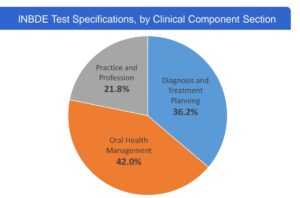
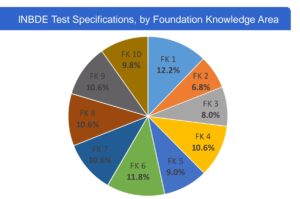
Sample Questions to Understand the Pattern of INBDE Exam
In the practice Questions given below you can see the Foundation Knowledge are (FK) and the Clinical Content Area (CC) in the bottom right corners.
These numbers correlate with the topics given in the tables above.This will help you understand the pattern of the INBDE exam and how question are asked according to the topics given above.
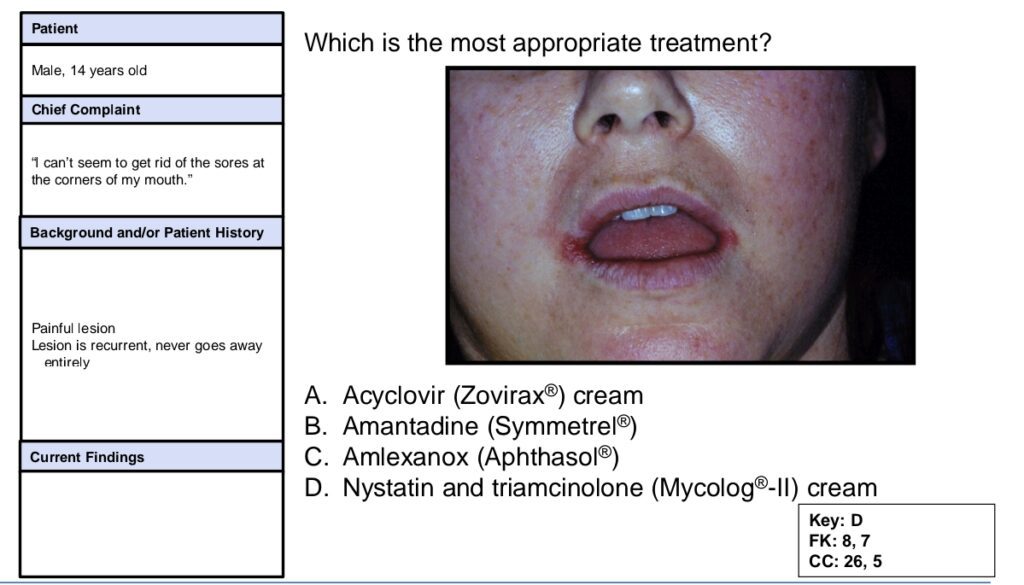
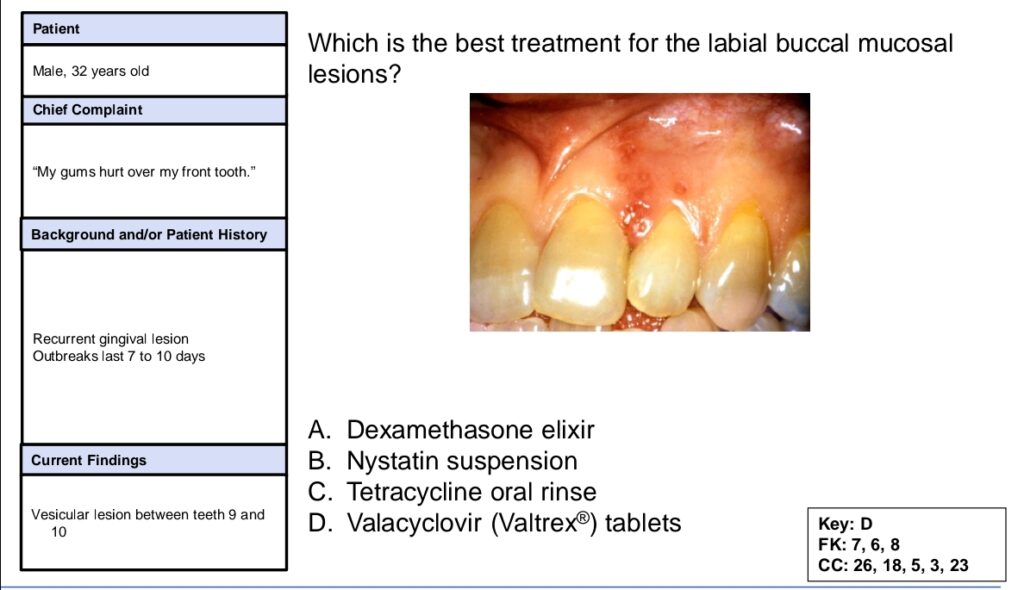
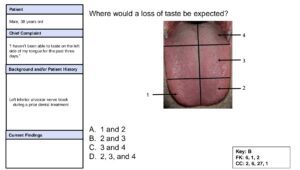
How to apply for DDS
Conclusion
To prepare for the INBDE, candidates typically use study materials and resources related to dental education and board preparation.
Reviewing coursework and textbooks from dental school is also essential.
It’s crucial for candidates to thoroughly review the official INBDE Guide provided by the Joint Commission on National Dental Examinations (JCNDE) for detailed information about the examination format, content, and eligibility requirements.
Additionally, consider using dental board review materials and practice exams to prepare effectively for this comprehensive examination.

I like it when people come together and share opinions. Great site, stick with it!
This info is worth everyone’s attention. How can I find out more?